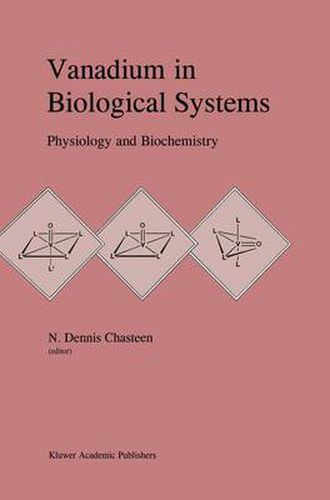Readings Newsletter
Become a Readings Member to make your shopping experience even easier.
Sign in or sign up for free!
You’re not far away from qualifying for FREE standard shipping within Australia
You’ve qualified for FREE standard shipping within Australia
The cart is loading…






This title is printed to order. This book may have been self-published. If so, we cannot guarantee the quality of the content. In the main most books will have gone through the editing process however some may not. We therefore suggest that you be aware of this before ordering this book. If in doubt check either the author or publisher’s details as we are unable to accept any returns unless they are faulty. Please contact us if you have any questions.
Over the past several decades, vanadium has increasingly attracted the interest of biologists and chemists. The discovery by Henze in 1911 that certain marine ascidians accumulate the metal in their blood cells in unusually large quantities has done much to stimulate research on the role of vanadium in biology. In the intervening years, a large number of studies have been carried out to investigate the toxicity of vanadium in higher animals and to determine whether it is an essential trace element. That vanadium is a required element for a few selected organisms is now well established. Whether vanadium is essential for humans remains unclear although evidence increasingly suggests that it probably is. The discovery by Cantley in 1977 that vanadate is a potent inhibitor of ATPases lead to numerous studies of the inhibitory and stimulatory effects of vanadium on phosphate metabolizing enzymes. As a consequence vanadates are now routinely used as probes to investigate the mechanisms of such enzymes. Our understanding of vanadium in these systems has been further enhanced by the work of Tracy and Gresser which has shown striking parallels between the chemistry of vanadates and phosphates and their biological compounds. The observation by Shechter and Karlish, and Dubyak and Kleinzeller in 1980 that vanadate is an insulin mimetic agent has opened a new area of research dealing with the hormonal effects of vanadium. The first vanadium containing enzyme, a bromoperoxidase from the marine alga Ascophyllum nodosum, was isolated in 1984 by Viltner.
$9.00 standard shipping within Australia
FREE standard shipping within Australia for orders over $100.00
Express & International shipping calculated at checkout
This title is printed to order. This book may have been self-published. If so, we cannot guarantee the quality of the content. In the main most books will have gone through the editing process however some may not. We therefore suggest that you be aware of this before ordering this book. If in doubt check either the author or publisher’s details as we are unable to accept any returns unless they are faulty. Please contact us if you have any questions.
Over the past several decades, vanadium has increasingly attracted the interest of biologists and chemists. The discovery by Henze in 1911 that certain marine ascidians accumulate the metal in their blood cells in unusually large quantities has done much to stimulate research on the role of vanadium in biology. In the intervening years, a large number of studies have been carried out to investigate the toxicity of vanadium in higher animals and to determine whether it is an essential trace element. That vanadium is a required element for a few selected organisms is now well established. Whether vanadium is essential for humans remains unclear although evidence increasingly suggests that it probably is. The discovery by Cantley in 1977 that vanadate is a potent inhibitor of ATPases lead to numerous studies of the inhibitory and stimulatory effects of vanadium on phosphate metabolizing enzymes. As a consequence vanadates are now routinely used as probes to investigate the mechanisms of such enzymes. Our understanding of vanadium in these systems has been further enhanced by the work of Tracy and Gresser which has shown striking parallels between the chemistry of vanadates and phosphates and their biological compounds. The observation by Shechter and Karlish, and Dubyak and Kleinzeller in 1980 that vanadate is an insulin mimetic agent has opened a new area of research dealing with the hormonal effects of vanadium. The first vanadium containing enzyme, a bromoperoxidase from the marine alga Ascophyllum nodosum, was isolated in 1984 by Viltner.